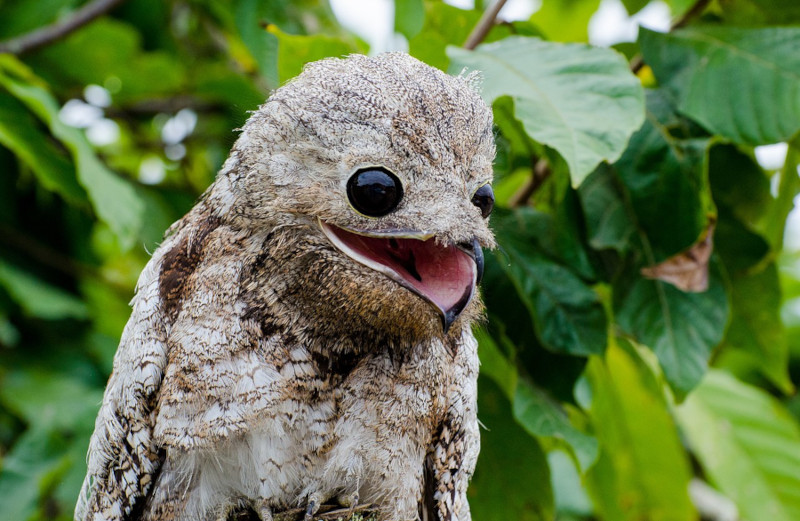
Great Potoo Facts
- This extraordinary avian, with its seemingly bizarre appearance, most frequently goes by the deceptively simple common name of the Great Potoo. It does have at least one alternate title, though. That’s the very similar moniker of grand potoo.
- Among scientific professionals, however, it’s more often referred to by its technical name. Thankfully, that’s a comparatively easy term for the layperson to pronounce. That’s because this intriguing bird holds the short official title of Nyctibius grandis.
- It received that blessedly simple formal title due to the efforts of the German naturalist, Johann Friedrich Gmelin. This noted researcher achieved the first acknowledgement of it as a separate and distincts species. He managed that noteworthy feat in 1789.
- No matter which of these various appellations one uses, it remains an impressive creature. It also holds the distinction of being the largest of all known varieties of potoo. Currently, six related species exist, placed within the same genus, Nyctibius.
- Luckily, the Great Potoo seems to be maintaining a population base that’s both stable and sufficient. That pleasant situation further appears to hold true throughout the entirety of its range. The IUCN thus presently lists it as Least Concern on its Red List.
- The animal nonetheless faces a few potential threats to its existence, however. The most immediate of these consists of habitat loss due to deforestation. It’s also potentially endangered by the same effects of ongoing climate change as other species.
Related Articles
Long Eared Owl
Tawny Frogmouth
Great Potoo Physical Description
The remarkable Great Potoo fully merits appreciation for being the marvel of evolution that it is. In this creature, Nature created a truly intriguing animal. It earns its notice mainly due to its appearance, however. In terms of size, it’s a roughly average-sized bird.
It does stand out physically in one respect, though, other than how it looks. That’s in the fact that, unlike many species, it displays no noticeable degree of the physiological trait known as sexual dimorphism. Both genders thus remain nearly indistinguishable to the eye.
Individuals of both sexes therefore attain approximately the same measurements in all respects. An average body length for this amazing bird ranges from 19 – 24 in (48 – 60 cm). Mass also naturally varies accordingly, but averages 0.81 – 1.44 lb (0.37 – 0.65 kg).
The typical wingspan for the animal also varies, regardless of sex. Interestingly, it does not do so to as great of a degree as the weight, though. This measurement ranges from 27.6 – 31.7 in (70.0 – 80.4 cm). A general average for this equals about 28.93 in (73.5 cm).
In terms of coloring, the Great Potoo presents a distinctive pattern. Its feathers typically present a pattern of color that varies between individuals. This generally consists of a mixture of gray, white, black, and burgundy. White bars also cross the tail in a lateral manner.
Yet its eyes remain its most striking feature. These develop as quite large in relation to the head. They also appear a dark brown and display a yellow iris. The head additionally grows large in relation to the body. Its wings are elliptical in shape, and the tail grows elongated.
- Kingdom: Animalia
- Phylum: Chordata
- Class: Aves
- Order: Nyctibiiformes
- Family: Nyctibiidae
- Genus: Nyctibius
- Species: N. grandis
Great Potoo Distribution, Habitat, and Ecology
The unusual bird known as the Great Potoo evolved as native to a moderate-sized expanse of the globe. Its exact zone of habitation likely won’t surprise many people, however. That’s because the animal shares its general range with all other known species of potoo.
That range consists of parts of both North America and South America. The most northerly known section of its territory reaches up to southern Mexico. From there, it appears in most of Central America. To the south, it lives as far as southeast Bolivia and Brazil.
The winged wonder also evolved very specific preferences in terms of its habitat. If necessary, though, it’s proven itself to be quite adaptible, as well, in this regard. Principally, however, the avian prefers to make its home in either humid or semi-humid forested regions.
Most specimens live in dense forest, preferably in lowland regions. Some do, though, appear at altitudes of up to 4,921 ft (1,500 m). It’s also seen around edges of forest and clearings. The creature sometimes ventures into open meadows, but only if the forest is nearby.
The Great Potoo evolved as nocturnal in nature. The carnivorous predator typically perches high in the canopy, waiting to pounce on unsuspecting prey. It mainly consumes larger flying insects, such as katydids and beetles, but sometimes bats and smaller birds.
Breeding generally occurs between February to August. Females usually lay a single egg, yet relatively little is known about their brooding behavior. Hatchlings mature quickly, reaches two-thirds of the size of an adult within 5 weeks! An average lifespan remains unknown.
This incredible avian also captures the imagination and attention of many due to a remarkable attribute. Perhaps its best known characteristic is the distinctive sound it makes. During most of the night, it utters a unique sound, thought to resemble a moaning growl by many people
Species Sharing Its Range
Check out our other articles on 4 Gorgeous European Gorges, Harp Seal, Cheddar Gorge, Southern Plains Bumblebee, Kinnikinnick, Mangrove Monitor, Axolotl
